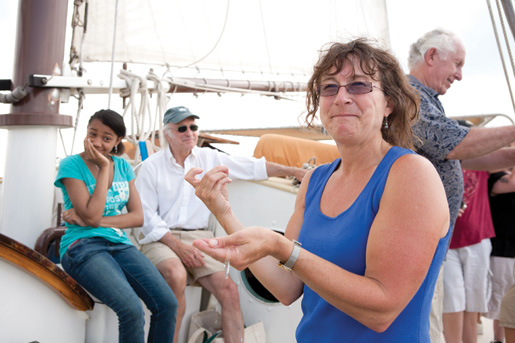Pass the jellyfish—but hold the sea nettle!
Jellyfish may not have been on the menu for patrons sailing on the Alliance out of Yorktown in July, but with Deborah Steinberg onboard, jellyfish were served.
Specifically comb jellies, or Mnemiopsis, freshly hauled from the York, were offered to guests to observe, to hold or to eat. “Go ahead and try it,” Steinberg urged. “It tastes just like saltwater-flavored Jello!”
The hors d’oeuvres came toward the end of a two-hour cruise in which Steinberg, a zooplankton ecologist and a professor of marine science at the Virginia Institute of Marine Science (VIMS), spoke in general about plankton, the small drifting plants (phytoplankton) and animals (zooplankton) that inhabit the Earth’s waters. Her lecture summarized her research through VIMS, including her participation in climate-change based studies on zooplankton west of the Antarctic Peninsula, the monitoring the 1,000-mile Amazon plume in the North Atlantic, and additional studies in the Sargasso Sea off Bermuda. For the most part, however, she focused her remarks on the Bay.
“In the Chesapeake, we’re particularly interested in the
jelly-plankton,” she said. She described how “blooms of jellyfish” occur
during the summer season, including vast increases in sea nettles, the
creature most likely to sting a bather in the Bay. These blooms, she
noted, are occurring approximately one month before they would have been
expected to occur ten years ago, a pattern change she attributed to
global warming. Because jellyfish are carnivores, eating fish larvae and
young invertebrates, including crabs, the impact of their earlier
arrival on the overall ecosystem is the subject of intense concern, she
explained.
A highlight of the cruise was the plankton tow.
Working in concert with Alliance captain Greg Lohse, Steinberg dropped a
plankton net over the side and ultimately pulled up several specimens,
including a sea nettle and comb jellies. Each was passed around, with a
caution not to touch the nettle but with encouragement to handle and
even partake of the comb jellies.
During the cruise, Steinberg passed around specimens recovered from
her work worldwide, produced a package of jellyfish available in Chinese
markets and quizzed fellow passengers concerning effective treatments
for jellyfish stings. Dousing a sting with fresh water heightens the
release of stinging toxins, she said. Likewise, the folk-remedy of
urinating on the affected area aggravates the sting.
The best
thing to do is to scrape the affected area with a credit card to remove
the stinging cells and then to topically apply meat tenderizer,
Steinberg said.
The “zooplankton” cruise was one of nine
Wednesday afternoon “Science Under Sail” excursions aboard Alliance that
featured scientists from VIMS during the summer.
According to Captain Lohse, the Science Under Sail series benefits
both Alliance patrons and the schooner’s crew, who get to learn more
about the Chesapeake watershed than otherwise would be possible. “It
adds another dimension to our trips and just makes it more fun for us,”
he said. ![]()















